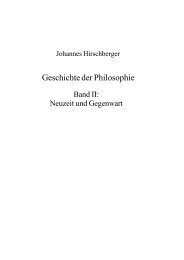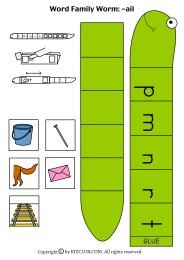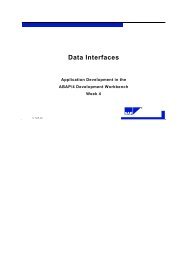- Page 2:
This page intentionally left blank
- Page 8:
Lambda-Calculus and Combinators, an
- Page 12:
To Carol, Goldie and Julie
- Page 16:
Contents vii 6C Equivalence of theo
- Page 20:
Preface The λ-calculus and combina
- Page 24:
Preface xi Last but of course not l
- Page 30:
2 The λ-calculus wrote f = λx . x
- Page 34:
4 The λ-calculus Notation 1.3 Capi
- Page 38:
6 The λ-calculus (a) lgh(a) = 1 fo
- Page 42:
8 The λ-calculus Remark 1.13 The p
- Page 46:
10 The λ-calculus (b) The relation
- Page 50:
12 The λ-calculus β-contractions
- Page 54:
14 The λ-calculus Before the theor
- Page 58:
16 The λ-calculus Exercise 1.36
- Page 62:
18 The λ-calculus Corollary 1.41.5
- Page 66:
20 The λ-calculus of the theory, a
- Page 70:
22 Combinatory logic S, a stronger
- Page 74:
24 Combinatory logic 2B Weak reduct
- Page 78:
26 Combinatory logic Exercise 2.16
- Page 82:
28 Combinatory logic Exercise 2.22
- Page 86:
30 Combinatory logic Theorem 2.32 (
- Page 90:
32 Combinatory logic (v) B(BS)Bxyzu
- Page 94:
34 The power of λ and CL term whos
- Page 98:
36 The power of λ and CL Remark Tu
- Page 102:
38 The power of λ and CL them a su
- Page 106:
40 The power of λ and CL 3D The qu
- Page 110:
42 The power of λ and CL X1 ≡ SI
- Page 114:
44 The power of λ and CL he publis
- Page 118:
46 The power of λ and CL ion-proce
- Page 122:
48 Computable functions to a β-nor
- Page 126:
50 Computable functions The first s
- Page 130:
52 Computable functions φ (k +1)x1
- Page 134:
54 Computable functions (r, s ≥ 0
- Page 138:
56 Computable functions 4C Recursiv
- Page 142:
58 Computable functions Definition
- Page 146:
60 Computable functions Theorem 4.2
- Page 150:
62 Computable functions where D ≡
- Page 154:
64 Undecidability gd(X), in honour
- Page 158:
66 Undecidability φ(j) =1 =⇒ F
- Page 162:
68 Undecidability Prove that the ge
- Page 166:
70 Formal theories or theorem of T
- Page 170:
72 Formal theories Remark 6.8 By th
- Page 174:
74 Formal theories conclusion, and
- Page 178:
7 Extensionality in λ-calculus 7A
- Page 182:
78 Extensionality in λ-calculus MQ
- Page 186:
80 Extensionality in λ-calculus Th
- Page 190:
8 Extensionality in combinatory log
- Page 194:
84 Extensionality in CL (c) S(KX)I
- Page 198:
86 Extensionality in CL Corollary 7
- Page 202:
88 Extensionality in CL other axiom
- Page 206:
90 Extensionality in CL (b) S(KX)(K
- Page 210:
9 Correspondence between λ and CL
- Page 214:
94 Correspondence between λ and CL
- Page 218:
96 Correspondence between λ and CL
- Page 222: 98 Correspondence between λ and CL
- Page 226: 100 Correspondence between λ and C
- Page 230: 102 Correspondence between λ and C
- Page 234: 104 Correspondence between λ and C
- Page 238: 106 Correspondence between λ and C
- Page 242: 108 Simple typing, Church-style (a)
- Page 246: 110 Simple typing, Church-style (b)
- Page 250: 112 Simple typing, Church-style Def
- Page 254: 114 Simple typing, Church-style so
- Page 258: 116 Simple typing, Church-style (a)
- Page 262: 118 Simple typing, Church-style The
- Page 266: 120 Simple typing, Curry-style in C
- Page 270: 122 Simple typing, Curry-style in C
- Page 276: 11B The system TA → C and this is
- Page 280: (c) U W UW 11D Abstraction 127 UW(V
- Page 284: 11D Abstraction 129 Case 4: X ≡ X
- Page 288: 11E Subject-reduction 131 Definitio
- Page 292: 11E Subject-reduction 133 Therefore
- Page 296: 11F Typable CL-terms 135 there exis
- Page 300: 11G Link with Church’s approach 1
- Page 304: 11H Principal types 139 (i) Γ is a
- Page 308: 11H Principal types 141 Also, if x
- Page 312: 11I Adding new axioms 143 S (a→b
- Page 316: 11I Adding new axioms 145 Definitio
- Page 320: 11J Propositions-as-types 147 easil
- Page 324:
11J Propositions-as-types 149 Discu
- Page 328:
11J Propositions-as-types 151 possi
- Page 332:
11J Propositions-as-types 153 Remar
- Page 336:
11K The equality-rule Eq ′ 155 11
- Page 340:
11K The equality-rule Eq ′ 157 Co
- Page 344:
12 Simple typing, Curry-style in λ
- Page 348:
12A The system TA → λ 161 Deduct
- Page 352:
12A The system TA → λ 163 such t
- Page 356:
12B Basic properties 165 Term Type
- Page 360:
12B Basic properties 167 under redu
- Page 364:
12B Basic properties 169 then follo
- Page 368:
12C Typable λ-terms 171 Example 12
- Page 372:
12D Propositions-as-types 173 (b) L
- Page 376:
12D Propositions-as-types 175 to ea
- Page 380:
12E Rule Eq ′ If this replacement
- Page 384:
12E Rule Eq ′ atypetoλx.xx). The
- Page 388:
13B Dependent function types 181 13
- Page 392:
(G i) [x : σ] M : τ (λx.M) :Gσ(
- Page 396:
13C Basic generalized typing 185 De
- Page 400:
13D Deductive rules 187 (axiom) ⊢
- Page 404:
13D Deductive rules 189 If this rul
- Page 408:
and the modified form of rule (Π i
- Page 412:
(axiom) ⊢ ⋆ : ✷ (start) Γ
- Page 416:
13E Church typing in λ 195 proofs
- Page 420:
13E Church typing in λ 197 The sys
- Page 424:
13E Church typing in λ 199 and (λ
- Page 428:
13E Church typing in λ 201 Remark
- Page 432:
13F Normalization in PTSs 203 Defin
- Page 436:
13F Normalization in PTSs 205 Remar
- Page 440:
13F Normalization in PTSs 207 Lemma
- Page 444:
13G Propositions-as-types 209 13G P
- Page 448:
13G Propositions-as-types 211 It is
- Page 452:
13G Propositions-as-types 213 We us
- Page 456:
and It is also easy to show that an
- Page 460:
13H PTSs with equality 217 Hence, b
- Page 464:
13H PTSs with equality 219 Furtherm
- Page 468:
14A Applicative structures 221 of C
- Page 472:
14B Combinatory algebras 223 For ev
- Page 476:
14B Combinatory algebras 225 Warnin
- Page 480:
14B Combinatory algebras 227 Defini
- Page 484:
15 Models of λ-calculus 15A The de
- Page 488:
15A The definition of λ-model 231
- Page 492:
15A The definition of λ-model 233
- Page 496:
15A The definition of λ-model 235
- Page 500:
15B Syntax-free definitions 237 Dis
- Page 504:
15B Syntax-free definitions 239 Cas
- Page 508:
15B Syntax-free definitions 241 Con
- Page 512:
15C General properties of λ-models
- Page 516:
15C General properties of λ-models
- Page 520:
16 Scott’s D∞ and other models
- Page 524:
16A C.p.o.s 249 λd ∈ D.φ(d) (
- Page 528:
16A C.p.o.s 251 computable function
- Page 532:
16B Continuous functions 253 Exerci
- Page 536:
Proof Straightforward. 16B Continuo
- Page 540:
16C The construction of D∞ That i
- Page 544:
16C The construction of D∞ But φ
- Page 548:
16D Properties of D∞ 16D Basic pr
- Page 552:
16D Properties of D∞ Thus a0, a1,
- Page 556:
16D Properties of D∞ Lemma 16.47
- Page 560:
16E D∞ is a λ-model 267 16E D∞
- Page 564:
16E D∞ is a λ-model 269 = ψr
- Page 568:
16F Other models 271 16F Some other
- Page 572:
16F Other models 273 versions of P
- Page 576:
16F Other models 275 algebras to pr
- Page 580:
α-conversion 277 P ⊲1β (λx.(λ
- Page 584:
α-conversion 279 Lemma A1.7 For al
- Page 588:
α-conversion 281 Corollary A1.14.1
- Page 592:
A2A β-reduction 283 By Appendix A1
- Page 596:
A2A β-reduction 285 making [N/x]M,
- Page 600:
A2A β-reduction 287 Case 4: M ≡
- Page 604:
A2B Other reductions 289 where the
- Page 608:
A2B Other reductions 291 Next, defi
- Page 612:
Appendix A3 Strong normalization pr
- Page 616:
A3A SN for λ 295 Lemma A3.10 Let
- Page 620:
A3B SN for CLw 297 M ⋆ N ≡ (λx
- Page 624:
A3C SN for CLZ → KXY U1 ...Un ⊲
- Page 628:
A3C SN for CLZ → term Zτ m, and
- Page 632:
A3C SN for CLZ → Basis (m =0and m
- Page 636:
Appendix A4 Care of your pet combin
- Page 640:
Appendix A5 Answers to starred exer
- Page 644:
Answers to starred exercises 309 (
- Page 648:
Finally, for 1 ≤ i ≤ k, Answers
- Page 652:
Answers to starred exercises 313 as
- Page 656:
Answers to starred exercises 315 11
- Page 660:
(c) (d) 1 [x : σ →σ →τ] Answ
- Page 664:
Answers to starred exercises 319 Th
- Page 668:
Answers to starred exercises 321 To
- Page 674:
324 References [Bar84] H. P. Barend
- Page 678:
326 References [Chu41] A. Church. T
- Page 682:
328 References [HS80] J. R. Hindley
- Page 686:
330 References [ML75] P. Martin-Lö
- Page 690:
332 References [Sco76] D. S. Scott.
- Page 694:
0, numeral in typing system, 214 0,
- Page 698:
336 List of symbols λ-model, 231 a
- Page 702:
338 Index B, 21 in λ, 34 assigning
- Page 706:
340 Index extensionality axioms, se
- Page 710:
342 Index numerals abstract, 61 of
- Page 714:
344 Index standardization, 42 (star

















